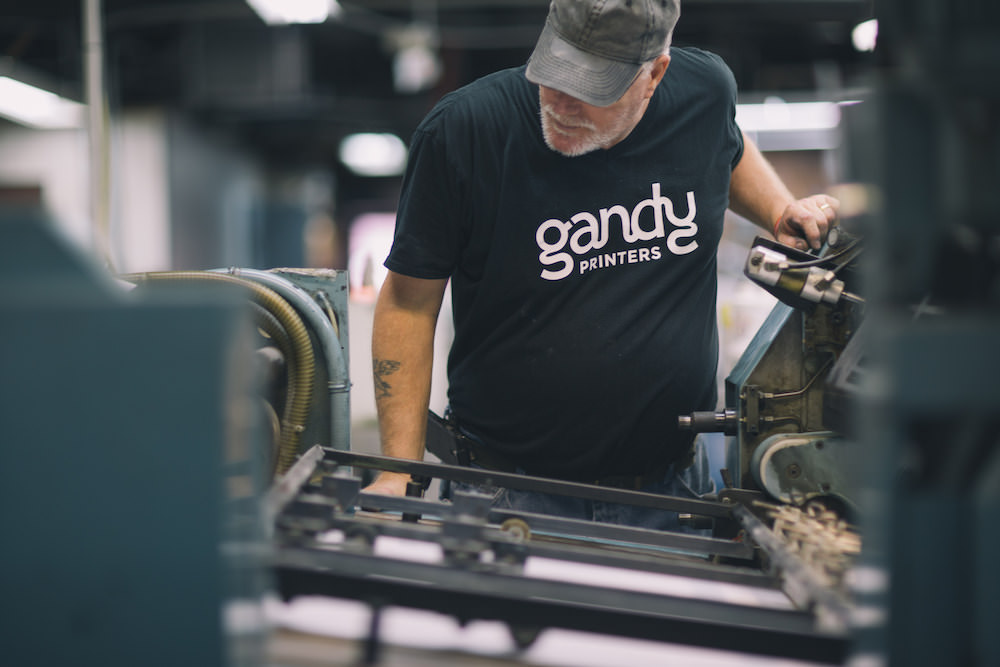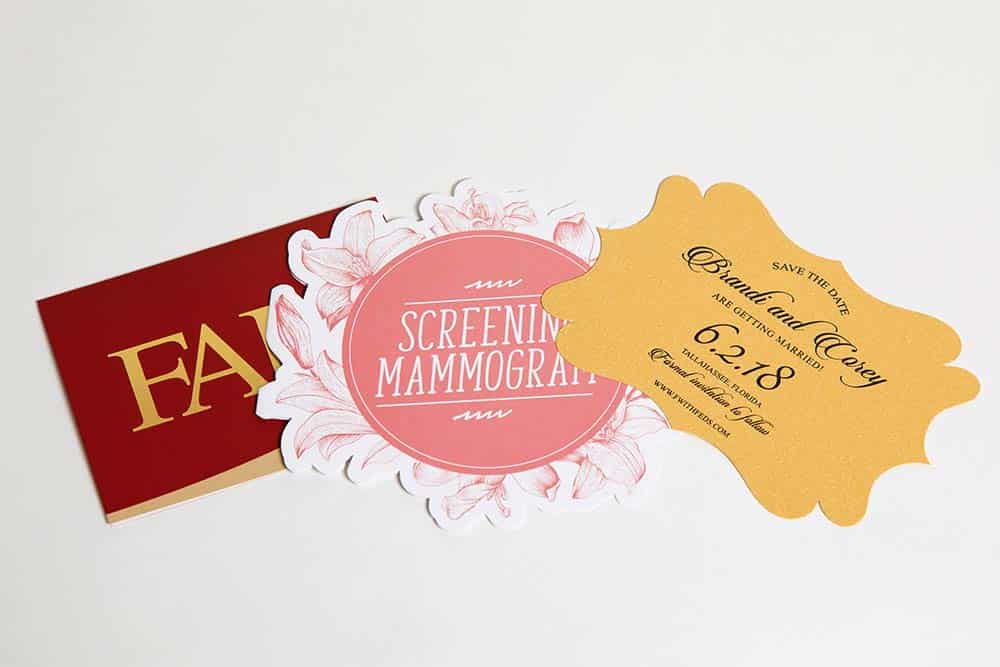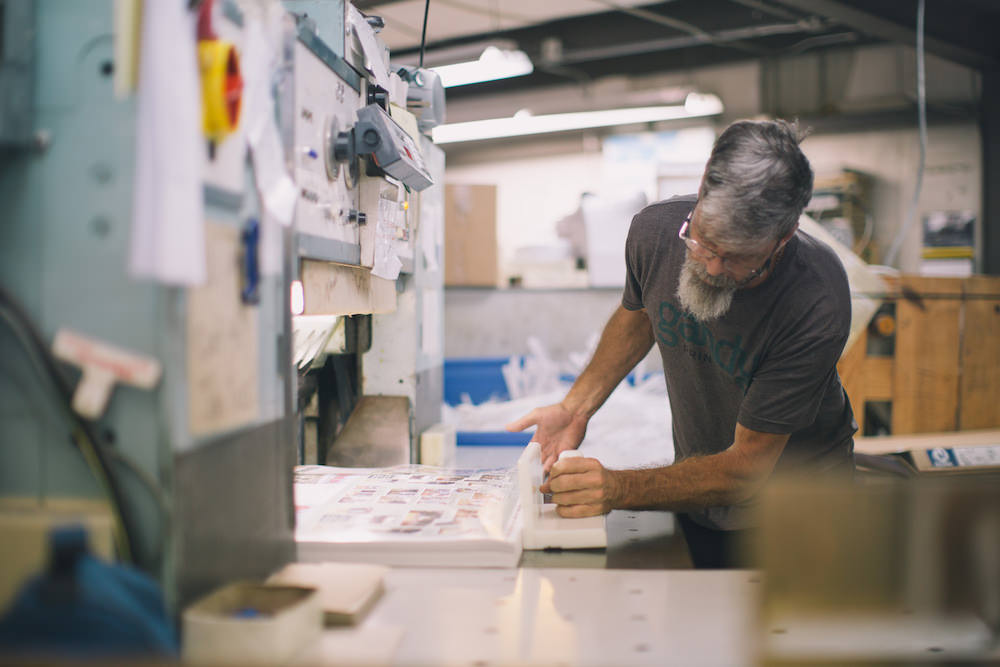In the world of printing, there are two dominant techniques that we often come across: offset and digital printing.
Both methods offer unique advantages and cater to different project needs, so we need to understand their key differences to make informed decisions for our printing projects.
Offset printing, or lithography, is popular for high-volume commercial jobs.
This technique is known for producing crisp and clean black-and-white text and colorful graphics.
It uses wet ink and can print on various materials and surfaces, offering numerous finishes like foil stamping, embossing, and UV coatings source.
On the other hand, digital printing, which used to be called “copying,” is a modern approach ideal for shorter runs and variable data projects.
This method provides a more straightforward, cost-effective solution when quantities are small or when quicker turnaround times and customization are needed source.
As we delve deeper into these printing techniques, we will compare their size, color, cost, and other factors that influence the quality and efficiency of our print projects.
In doing so, we can determine which method aligns best with our specific requirements and ensure the best outcome for our printed materials.
A Quick Overview of Offset and Digital Printing
Offset Printing
Offset printing is a widely used method that involves transferring ink from custom-made plates onto a rubber blanket, which then rolls onto the desired substrate, such as paper.

This technology is known for producing high-quality prints with accurate colors on a wide variety of substrates and sizes. It’s particularly cost-effective for long runs.
In recent years, offset printing has significantly reduced its environmental impact.
Manufacturers have developed more eco-friendly inks and implemented waste-reduction measures associated with the process.
Digital Printing
Digital printing, on the other hand, is a modern and flexible process that operates much like a home printer. It’s beneficial for quick executions, on-demand printing, and smaller runs.

The digital technique uses less power, creates less waste, and produces fewer toxic byproducts than offset printing, thus having a generally lower environmental impact.
Digital printers create colors by blending CMYK inks, which may be sufficient for basic four-color printing.
However, these printers can sometimes struggle to match the exact hues produced by the Pantone Matching System, which is used more commonly in offset printing.
Both offset and digital printing have their strengths and limitations.
Selecting the most suitable method depends on factors such as volume, budget, and color accuracy requirements.
Printing Process For Each Method
This section will discuss the two main types of printing processes, offset and digital, and their respective sub-processes.
Offset Printing Process
Offset printing, also known as lithography, is a traditional printing process that utilizes plates and ink to create high-quality printed materials.
The process begins with creating an image on a plate, typically made of aluminum.
The plate is then coated with an emulsion that is sensitive to light, which hardens in the areas exposed to the image.
The unexposed areas are washed away, leaving a clear image on the plate.
Next, the plate is mounted on a press, which transfers the ink onto a set of rubber blankets. These blankets, in turn, press the ink onto the paper or other desired material.
Unlike digital printing, offset printing uses a separate plate for each color, typically using the CMYK color model (cyan, magenta, yellow, and black).
This allows for highly accurate color reproduction and sharp detail in the final print.
📌 At Gandy Printers, we utilize an LED-UV offset press, which uses inks cured by an LED lamp. This means that the ink on our offset printing comes out dry, much like the toner used in digital printing. This ensures no smudging or offsetting of the ink during post-press processes like cutting or folding.
Some critical aspects of the offset printing process include:
- Utilizes plates and ink to transfer images
- Separate plate for each color
- Highly accurate color reproduction
- Ideal for large print runs
Digital Printing Process
Digital printing, on the other hand, does not use plates. Instead, it relies on either dry toner (as in laser printers) or liquid ink in inkjet printers.
The technology enables direct printing of an image from digital files, which means faster setup times and lower costs for smaller print runs.
Laser printers use a combination of heat and pressure to fix the dry toner onto the material, creating images or text with consistent quality.
Inkjet printers, meanwhile, dispense liquid ink onto the material in tiny droplets, allowing for high-resolution and color-rich prints.
Some key aspects of digital printing include:
- Does not use plates; relies on toner or liquid ink
- Faster setup times for smaller print runs
- Lower costs for low-quantity projects
- High-resolution and color-rich prints are possible
In summary, we have discussed the basics of offset and digital printing processes, their differences, and the advantages of each.
These points can help you make an informed decision when selecting the best printing method for your project.
Comparing Quality and Color Accuracy
Offset Printing Quality
Offset printing is known for its high quality and color accuracy. It delivers clean, distinct type and images without streaks or spots.
Offset printing is particularly suitable for projects that demand exact color reproduction, as it uses the Pantone Matching System (PMS) for color fidelity.
This system allows for premixed inks to maintain precise color throughout the printing process, resulting in higher-quality print jobs source.
One advantage of offset printing is its superior color fidelity.
Businesses can use Pantone colors instead of the standard CMYK, giving offset printing the edge in color accuracy source.
Whether you need sharp, accurate colors or black-and-white printing, offset printing can deliver the results you’re looking for.
Digital Printing Quality
Digital printing technology has come a long way and offers comparable print quality to offset printing.
While there may be some variations in color and minor susceptibility to scratching and scuffing, digital printing can provide excellent results for many projects source.
The color accuracy of digital printing might not be as exact as offset printing, particularly when it comes to utilizing Pantone colors, but the approximation of PMS colors in digital printing is still quite good.
Advanced digital presses, like our Xerox Iridesse, can produce sharp, high-quality prints that can meet the demands of various project sources.
Both offset and digital printing have their merits regarding quality and color accuracy.
The choice between the two will depend on the specific requirements of your project, such as the color accuracy needed, volume, and deadline.
Cost and Turnaround Time
Comparing Costs
When determining the most suitable printing method for a project, it’s important to consider the costs associated with each technique.
Offset printing has a higher fixed cost but a lower variable cost per unit, making it more cost-effective for large quantities.
On the other hand, digital printing has a lower fixed cost but a higher variable cost per unit. This means that digital printing is typically the more economical choice for small print runs.
Offset Printing Costs:
- Higher fixed cost (e.g., creating plates and setting up the press)
- Lower variable cost per unit (once set up and running, additional copies are inexpensive)
- More cost-effective for large print runs
Digital Printing Costs:
- Lower fixed cost (minimal materials and set up of the press is required)
- Higher variable cost per unit
- More cost-effective for small print runs
Turnaround Time
Another factor to consider when choosing between offset and digital printing is the time it takes to complete a project.
Digital printing offers a quicker turnaround time because there is no need for plates or ink adjustments.
This can be a key advantage if you’re working on a tight deadline or need to respond quickly to a client’s request.
In contrast, offset printing requires more time for setting up the printing process, including creating plates for each color. However, once everything is in place, offset printing can provide high-quality results for large print runs.
Offset Printing Turnaround Time:
- Longer setup time
- Quicker production time for large print runs
- Most jobs are turned in 5 to 7 working days
Digital Printing Turnaround Time:
- Faster setup time
- Quicker production time for small print runs
- Most jobs are turned in 2 to 3 working days
In conclusion, the choice between offset and digital printing depends on your specific project requirements.
Considering factors like cost, print run size, and turnaround time will help guide your decision-making process and ensure that you select the most appropriate printing method for your needs.
At Gandy Printers, we are happy to guide you through this decision-making process. Call us at 850-222-5847 or send us a message via our contact form.
Applications and Materials
Offset Printing Applications
Offset printing is an excellent choice for a variety of products and industries. It’s particularly suitable for large quantities and high-quality print jobs.

Some common applications include:
- Marketing materials: Brochures, flyers, and postcards often require a large print run and high-quality finish that offset printing provides.
- Magazines and Periodicals: As offset printing can handle large volumes economically, it’s ideal for magazines and newsletters.
- Books: The consistent quality and affordability of offset printing make it the go-to choice for book publishers.
- Business cards and stationery: The sharpness and color accuracy afforded by offset printing allows for crisp and professional-looking business cards and letterheads.
- Posters: For large-format items like posters, offset printing offers uniformity and precision in color reproduction.
A key advantage of offset printing is its ability to use a wide range of paper stocks and materials, including custom Pantone inks.
This ensures optimal results and opens up creative possibilities, such as foil stamping, embossing, and UV coatings.
Digital Printing Applications
Digital printing has made significant strides in quality and affordability over the years.

It provides an excellent alternative to offset for specific applications, such as:
- Short-run and on-demand printing: Digital printing is well-suited for lower quantities and situations where a quick turnaround is needed.
- Variable data printing: Projects that require personalization, like customized mailers or event invitations, can be efficiently produced with digital printing.
- Wide-format items: Digital printing technology accommodates the production of banners, window graphics, and oversized posters.
- Prototypes and samples: Its cost-effective nature and rapid turnaround make digital printing ideal for creating single-item proofs or test-runs.
Digital printing may not offer the same variety of options when it comes to paper stocks or custom colors as offset does. However, it’s a valuable and versatile tool for a wide range of applications.
Overall, choosing between digital and offset printing will largely depend on the specific requirements and end goal of your print project.
Variable Data and Personalization
In today’s highly competitive market, businesses need to stand out with targeted messaging and personalization.
One of the key advantages of digital printing over offset printing is its capability to handle variable data and personalization more efficiently.
Variable data printing (VDP) allows for customization of individual elements within each printed piece, without slowing down the overall printing process.
Through VDP, we can create personalized marketing materials such as direct mail, business cards, or brochures, with unique text, images, or graphics tailored to each recipient.
Digital printing is an excellent choice for projects that require personalization and variable data due to its flexibility and speed.
Unlike offset printing, which uses plates and is most cost-effective for large, static print runs, digital printing does not require any plates or setup fees, making it the preferred choice for smaller, personalized projects.
One application where we can see the benefits of variable data and personalization is in direct mail campaigns.
With digital printing, it’s easy to generate targeted messages for specific segments of your audience, increasing the likelihood of a positive response.
By incorporating unique elements such as names, addresses, and personalized offers, we can create a more relevant and engaging experience for the recipient.
In summary, digital printing’s ability to efficiently handle variable data and personalization makes it an excellent choice for businesses looking to create professional, customized materials that resonate with their target audience.
Additional Features and Finishing Options
When it comes to additional features and finishing options, both digital and offset printing have their advantages.
We’ll discuss some of the main differences between both methods, focusing on material, foil stamping, embossing, varnishes, UV coatings, and print quality.
In terms of material, digital printing is more flexible as it can print on a wider range of paper types and weights.
Offset printing, however, provides superior print quality and is generally better suited for large runs and full-color projects like booklets and brochures. This is because offset printing uses rubber sheet transfers, which allows for clean, high-quality prints.
Foil stamping is a popular finishing technique used to add a metallic effect to designs. This process can be incorporated with both digital and offset printing but tends to achieve better results with offset.
Embossing, on the other hand, can effectively produce raised designs and textures in print materials and is compatible with both printing methods.
Varnishes and UV coatings are commonly used to enhance and protect printed materials. While both digital and offset printing can incorporate varnishes, UV coatings are often more suitable for offset printing due to the nature of the printing process.
UV coatings help to enhance print quality and durability, especially with large print runs.
When it comes to print quality, offset printing often produces superior results in terms of color consistency, sharpness, and detail.
This is because offset printing allows for Pantone color matching instead of the CMYK color model typically used in digital printing.
This ensures higher color fidelity and a cleaner finish. However, digital printing is advantageous for short print runs and offers a faster turnaround time due to its streamlined process.
Based on these factors, it’s clear that both digital and offset printing have unique advantages when it comes to finishing options and printing quality. Considering the needs of your project will help you determine which method will provide the best results.
Choosing the Right Printing Method for Your Needs
Factors to Consider
When deciding between offset and digital printing for a project, it’s crucial to weigh the benefits and drawbacks according to the specific needs. There are several factors to consider, such as:
- Volume: Offset printing is more cost-effective for large print runs, while digital printing is more suitable for smaller volumes. The more copies you need, the cheaper offset printing becomes per unit.
- Materials: Offset printing can be used on a variety of material types, while digital printers are more limited. If your project requires printing on unique or non-standard materials, offset printing might be the better choice.
- Image Quality: Although both methods can produce high-quality prints, offset printing produces sharper and clearer images with a wider range of colors compared to digital printing.
- Turnaround Time: Digital printing has a faster turnaround time because it doesn’t require printing plates, making it perfect for time-sensitive projects. On the other hand, offset printing requires more setup time, but once the printing plates are prepared, the actual printing speed is faster.
- Eco-friendliness: Offset printing can be more eco-friendly if it uses soy-based ink and certified chain of custody paper. However, newer digital printers are also becoming more environmentally friendly, so both options can be considered.
- Customization: If your project requires variable data or personalization, digital printing is the better option as it can easily create unique prints in each copy. On the other hand, offset printing is not suited for such customized demands.
When selecting the right printing method for your project, it’s important to keep these factors in mind to ensure that your choice aligns with your specific project needs.
Remember that the most suitable option will depend on various elements, including volume, turnaround time, materials, and customization requirements.
By carefully considering these factors, you’ll be equipped to make the most informed decision for your printing project.
Conclusion and Future Trends
As we look ahead in the printing industry, the competition between offset and digital printing continues to evolve.
With advancements in print technology, digital options are becoming more prominent and gaining ground on their offset counterparts.
At Gandy Printers, we are taking notice of the industry trends and adapting our services accordingly.
One significant advantage of digital printing is the ability to produce faster turnaround times for clients.
Thanks to modern technology, digital printers can operate at higher speeds, resulting in a more efficient production process. This increased efficiency is ideal for businesses that require quick and personalized data printing.
In recent years, the focus on sustainability and eco-friendliness has gained momentum in the printing industry.
We’re seeing more use of biodegradable inks and toners, as well as sustainable printing practices that reduce waste and energy consumption.
A variety of papers, including FSC-certified options, are now available to cater to environmentally conscious customers.
In conclusion, we have witnessed the printing landscape shift, with digital printing making significant strides in terms of quality, speed, and sustainability.
While offset printing still plays a crucial role in providing consistent, high-quality output for large volumes, it’s clear that digital printing is carving out its place in the market and will continue to grow as technology advances.
Frequently Asked Questions
What are the main advantages of offset printing?
Offset printing offers several advantages compared to digital printing.
First, it typically provides superior image quality, with crisp, clean lines and vibrant colors.
Second, it can be more cost-effective for large print runs, as the price per unit decreases as the quantity increases.
Finally, offset printing supports a wider range of paper stock and finishes, allowing for greater customization in the final printed product.
How does the digital printing process work?
Digital printing uses digital files to create the printed image, either through inkjet or laser technology.
In a direct-to-paper approach, an image is formed by applying ink or toner directly onto the paper.
The lack of plates and the minimal setup time make digital printing quicker for short runs, allowing for faster turnaround times and lower costs on smaller orders.
Why might offset printing be preferred over digital printing?
Offset printing might be preferred over digital printing in certain situations.
For example, if a project requires precise color matching or a large volume of printed materials, offset printing would likely be the better choice.
Additionally, offset printing offers a wider range of paper and finishing options, which can help create a more premium or unique final product.
What are the pros and cons of digital and offset printing?
Digital printing has advantages such as fast turnaround times, cost-effectiveness for smaller print runs, and the ability to customize individual prints. However, the image quality may not be as high as offset printing, especially for detailed images or small text.
Offset printing offers higher image quality and cost-efficiency for large print runs. It also enables greater customization of materials and finishes.
The downsides include longer setup times, making it less suitable for urgent or small orders.
How does offset printing compare to screen and flexo printing?
Screen printing is a method used for printing on a variety of surfaces, from fabric to glass.
It’s versatile and can produce vibrant colors, but may not be appropriate for highly detailed images.
Flexo printing, or flexography, is a high-speed printing process that uses flexible relief plates, primarily utilized in packaging.
It’s efficient for large orders but might have higher costs for smaller print runs.
Offset printing provides high-quality images and works well for large print runs, serving as a more appropriate choice for commercial materials such as brochures, catalogs, and posters.
In what situations is digital printing more cost-effective than offset printing?
Digital printing is often more cost-effective than offset printing when it comes to smaller print runs.
As an example, a run of 2,000 pieces is generally the “break-even” point, meaning that jobs with fewer than 2,000 prints are more cost-effective using the digital printing process.
However, this may vary depending on the specific project.
References
- https://www.mohawkconnects.com/article/mohawk-blog/offset-vs-digital-sheets-how-theyre-different
- https://www.printingforless.com/resources/digital-printing-vs-offset-printing/
- https://blog.shawmutdelivers.com/quick-comparison-guide-digital-vs-offset-printing


